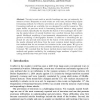Free Online Productivity Tools
i2Speak
i2Symbol
i2OCR
iTex2Img
iWeb2Print
iWeb2Shot
i2Type
iPdf2Split
iPdf2Merge
i2Bopomofo
i2Arabic
i2Style
i2Image
i2PDF
iLatex2Rtf
Sci2ools
ISI
2004
Springer
2004
Springer
Spatial Forecast Methods for Terrorist Events in Urban Environments
Abstract. Terrorist events such as suicide bombings are rare yet extremely destructive events. Responses to such events are even rarer, because they require forecasting methods for effective prevention and early detection. While many forecasting methods are available, few are designed for conflict scenarios. This paper builds on previous work in forecasting criminal behavior using spatial choice models. Specifically we describe the fusion of two techniques for modeling the spatial choice of suicide bombers into a unified forecast that combines spatial likelihood modeling of environmental characteristics with logistic regression modeling of demographic features. In addition to describing the approach we also provide motivation for the fusion of the methods and contrast the results obtained with those from the more common kernel density estimation methods that do not account for variation in the event space. We give an example of successful use of this combined method and an evaluation o...
| Added | 02 Jul 2010 |
| Updated | 02 Jul 2010 |
| Type | Conference |
| Year | 2004 |
| Where | ISI |
| Authors | Donald Brown, Jason Dalton, Heidi Hoyle |
Comments (0)

